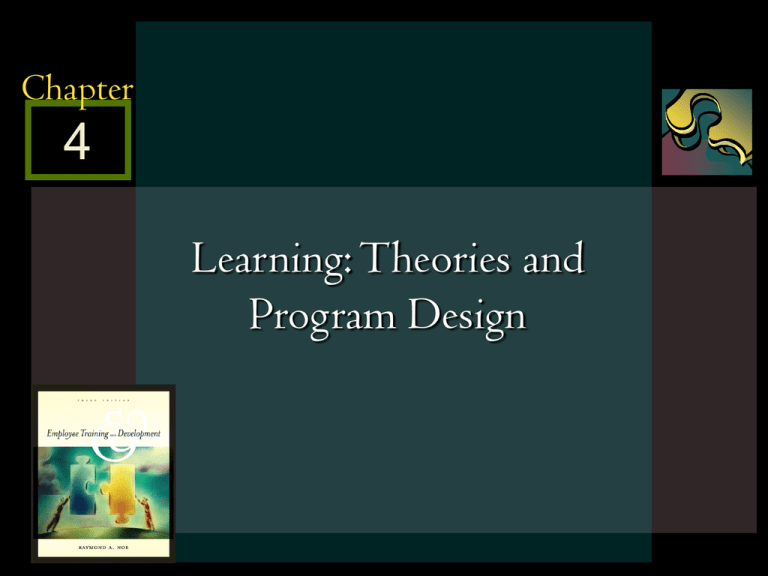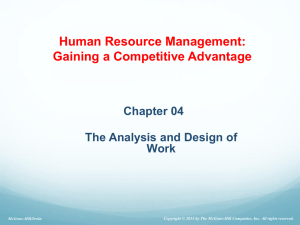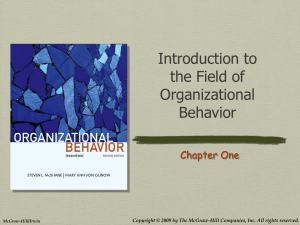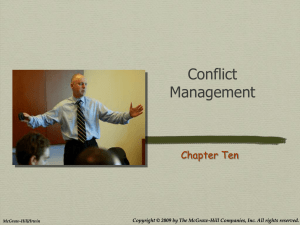
Chapter
4
Learning: Theories and
Program Design
McGraw-Hill/Irwin
© 2005 The McGraw-Hill Companies, Inc. All rights reserved.
4-1
Introduction (1 of 2)
Two conditions necessary for learning to occur:
1. opportunities for trainees to practice
2. meaningful content
For learning to occur it is important to identify
what is to be learned
i.e., to identify learning outcomes
McGraw-Hill/Irwin
© 2005 The McGraw-Hill Companies, Inc. All rights reserved.
4-2
Introduction (2 of 2)
Understanding learning outcomes is crucial
they influence the characteristics of the training
environment that are necessary for learning to occur
The design of the training program is also
important for learning to occur
McGraw-Hill/Irwin
© 2005 The McGraw-Hill Companies, Inc. All rights reserved.
4-3
What Is Learning?
Learning is a relatively
permanent change in human
capabilities that is not a
result of growth processes.
These capabilities are
related to specific learning
outcomes.
McGraw-Hill/Irwin
© 2005 The McGraw-Hill Companies, Inc. All rights reserved.
4-4
Learning Outcomes (1 of 3)
Verbal information
Includes names or labels, facts, and bodies of knowledge
Includes specialized knowledge employees need in their
jobs
Intellectual skills
Include concepts and rules
These are critical to solve problems, serve customers, and
create products
McGraw-Hill/Irwin
© 2005 The McGraw-Hill Companies, Inc. All rights reserved.
4-5
Learning Outcomes (2 of 3)
Motor skills
Include coordination of physical movements
Attitudes
Combination of beliefs and feeling that pre-dispose a
person to behave a certain way
Important work-related attitudes include job satisfaction,
commitment to the organization, and job involvement
McGraw-Hill/Irwin
© 2005 The McGraw-Hill Companies, Inc. All rights reserved.
4-6
Learning Outcomes (3 of 3)
Cognitive strategies
Regulate the process of learning
They relate to the learner’s decision regarding:
what information to attend to (i.e., pay attention to)
how to remember
how to solve problems
McGraw-Hill/Irwin
© 2005 The McGraw-Hill Companies, Inc. All rights reserved.
4-7
Learning Theories
Reinforcement
Theory
Social Learning
Theory
Goal Theories
Need Theories
Expectancy Theory
Information
Processing Theory
McGraw-Hill/Irwin
Adult Learning
Theory
© 2005 The McGraw-Hill Companies, Inc. All rights reserved.
4-8
Reinforcement Theory (1 of 2)
Emphasizes that people are motivated to perform
or avoid certain behaviors because of past
outcomes that have resulted from those behaviors
Positive reinforcement
Negative Reinforcement
Extinction
Punishment
McGraw-Hill/Irwin
© 2005 The McGraw-Hill Companies, Inc. All rights reserved.
4-9
Reinforcement Theory (2 of 2)
From a training perspective, it suggests that for
learners to acquire knowledge, change behavior,
or modify skills, the trainer needs to identify
what outcomes the learner finds most positive
(and negative)
Trainers then need to link these outcomes to
learners acquiring knowledge, skills, or changing
behaviors
McGraw-Hill/Irwin
© 2005 The McGraw-Hill Companies, Inc. All rights reserved.
4 - 10
Schedules of Reinforcement
Ratio Schedules
Interval Schedules
Fixed-ratio schedule
Fixed-interval schedule
Continuous reinforcement
Variable-interval schedule
Variable-ratio schedule
McGraw-Hill/Irwin
© 2005 The McGraw-Hill Companies, Inc. All rights reserved.
4 - 11
Social Learning Theory (1 of 2)
Emphasizes that people learn by observing other
persons (models) whom they believe are credible
and knowledgeable
Recognizes that behavior that is reinforced or
rewarded tends to be repeated
The models’ behavior or skill that is rewarded is
adopted by the observer
McGraw-Hill/Irwin
© 2005 The McGraw-Hill Companies, Inc. All rights reserved.
4 - 12
Social Learning Theory (2 of 2)
Learning new skills or behavior comes from:
directly experiencing the consequences of using
behavior or skills, or
the process of of observing others and seeing the
consequences of their behavior
Learning is also influenced by a person’s selfefficacy
self-efficacy is a person’s judgment about whether he
or she can successfully learn knowledge and skills
McGraw-Hill/Irwin
© 2005 The McGraw-Hill Companies, Inc. All rights reserved.
4 - 13
Processes of Social Learning Theory
Attention
• Model Stimuli
Retention
• Coding
• Trainee Characteristics • Organization
• Rehearsal
McGraw-Hill/Irwin
Motor
Reproduction
• Physical Capability
Motivational
Processes
Match
Modeled
Performanc
e
• Reinforcement
• Accuracy
• Feedback
© 2005 The McGraw-Hill Companies, Inc. All rights reserved.
4 - 14
Goal Theories
Goal Setting
Theory
McGraw-Hill/Irwin
Goal Orientation
© 2005 The McGraw-Hill Companies, Inc. All rights reserved.
4 - 15
Goal Setting Theory (1 of 3)
Goal setting theory assumes behavior results
from a person’s conscious goals and intentions
Goals influence behavior by:
directing energy and attention
sustaining effort over time
motivating the person to develop strategies for goal
attainment
McGraw-Hill/Irwin
© 2005 The McGraw-Hill Companies, Inc. All rights reserved.
4 - 16
Goal Setting Theory (2 of 3)
Specific challenging goals result in better
performance than vague, unchallenging goals
Goals lead to high performance only if people are
committed to the goal
Employees are less likely to be committed to a
goal if they believe it is too difficult
McGraw-Hill/Irwin
© 2005 The McGraw-Hill Companies, Inc. All rights reserved.
4 - 17
Goal Setting Theory (3 of 3)
Goal setting theory is used in training program
design
It suggests that learning can be facilitated by
providing trainees with specific challenging goals
and objectives
The influence of goal setting theory can be seen
in the development of training lesson plans
McGraw-Hill/Irwin
© 2005 The McGraw-Hill Companies, Inc. All rights reserved.
4 - 18
Goal Orientation (1 of 3)
Goal orientation – refers to the goals held by a
trainee in a learning situation
Mastery orientation: relates to trying to increase
ability or competence in a task
Performance orientation: refers to a focus of learners
on task performance and how they compare to others
McGraw-Hill/Irwin
© 2005 The McGraw-Hill Companies, Inc. All rights reserved.
4 - 19
Goal Orientation (2 of 3)
Goal orientation affects the amount of effort a
trainee will expend in learning (motivation to
learn)
Learners with a high mastery orientation –
direct greater attention to the task
learn for the sake of learning
McGraw-Hill/Irwin
© 2005 The McGraw-Hill Companies, Inc. All rights reserved.
4 - 20
Goal Orientation (3 of 3)
Learners with a high performance orientation –
direct more attention to performing well
devote less effort to learning
Trainees with a learning orientation exert greater
effort to learn and use more complex learning
strategies than trainees with a performance
orientation
McGraw-Hill/Irwin
© 2005 The McGraw-Hill Companies, Inc. All rights reserved.
4 - 21
Need Theories
Help explain the value that a person places on
certain outcomes
Suggest that to motivate learning:
trainers should identify trainees’ needs, and
communicate how training program content relates to
fulfilling these needs
If the basic needs of trainees are not met, they are
unlikely to be motivated to learn
McGraw-Hill/Irwin
© 2005 The McGraw-Hill Companies, Inc. All rights reserved.
4 - 22
Expectancy Theory (1 of 2)
Expectancy theory suggests that a person’s
behavior is based on three factors:
expectancy
instrumentality
valance
McGraw-Hill/Irwin
© 2005 The McGraw-Hill Companies, Inc. All rights reserved.
4 - 23
Expectancy Theory (2 of 2)
Expectancy theory suggests that learning is most
likely to occur when employees believe:
They can learn the content of the program
(expectancy)
Learning is linked to outcomes such as better job
performance, a salary increase, or peer recognition
(instrumentality)
Employees value these outcomes
McGraw-Hill/Irwin
© 2005 The McGraw-Hill Companies, Inc. All rights reserved.
4 - 24
Expectancy Theory of Motivation
Expectancy
Effort
Performance
Does Trainee Have
Ability to Learn?
Does Trainee Believe He
Can Learn?
McGraw-Hill/Irwin
X
Instrumentality
Performance
Outcome
Does Trainee Believe
Training Outcomes
Promised Will Be
Delivered?
Valance
X
Value of Outcome
= Effort
Are Outcomes Related
to Training Valued?
© 2005 The McGraw-Hill Companies, Inc. All rights reserved.
4 - 25
Adult Learning Theory
It is based on several assumptions:
Adults have the need to know why they are learning
something
Adults have a need to be self-directed
Adults bring more work-related experiences into the
learning situation
Adults enter into a learning experience with a
problem-centered approach to learning
Adults are motivated to learn by both extrinsic and
intrinsic motivators
McGraw-Hill/Irwin
© 2005 The McGraw-Hill Companies, Inc. All rights reserved.
4 - 26
Implications of Adult Learning Theory for
Training:
Design Issue
Implications
Self – concept
Mutual planning and collaboration in instruction
Experience
Use learner experience as basis for examples and applications
Readiness
Develop instruction based on learner’s interests and competencies
Time perspective
Immediate application of content
Orientation to
learning
Problem – centered instead of subject – centered
McGraw-Hill/Irwin
© 2005 The McGraw-Hill Companies, Inc. All rights reserved.
4 - 27
Information Processing Theory
These theories give more emphasis to the internal
processes that occur when training content is
learned and retained
Highlights how external events influence learning
McGraw-Hill/Irwin
© 2005 The McGraw-Hill Companies, Inc. All rights reserved.
4 - 28
A Model of Human Information Processing
Stimulus
or
Message
Receptors
Eyes
Ears
Nose
Skin
Environment
Feedback
Reinforcement
McGraw-Hill/Irwin
Effectors
Sensory
Register
Short-Term
Memory
Long-Term
Memory
Response
Generator
© 2005 The McGraw-Hill Companies, Inc. All rights reserved.
4 - 29
The Learning Process
This material asks three questions:
1. What are the physical and mental processes
involved in learning?
2. How does learning occur?
3. Do trainees have different learning styles?
McGraw-Hill/Irwin
© 2005 The McGraw-Hill Companies, Inc. All rights reserved.
4 - 30
The Learning Process:
Mental and Physical Processes
Gratifying
Generalizing
Retrieval
McGraw-Hill/Irwin
Expectancy
Perception
LEARNING
Long –Term
Storage
Working
Storage
Semantic
Encoding
© 2005 The McGraw-Hill Companies, Inc. All rights reserved.
4 - 31
The Learning Process:
Learning Styles
Diverger
Converger
Concrete experience
Reflective observation
Assimilator
Abstract
conceptualization
Reflective observation
McGraw-Hill/Irwin
Abstract
conceptualization
Active experimentation
Accommodator
Concrete experience
Active experimentation
© 2005 The McGraw-Hill Companies, Inc. All rights reserved.
4 - 32
Implications of the Learning Process for
Instruction: (1 of 2)
Employees need to know why they should learn
Employees need meaningful training content
Employees need opportunities to practice
Employees need to commit training content to
memory
Employees need feedback
McGraw-Hill/Irwin
© 2005 The McGraw-Hill Companies, Inc. All rights reserved.
4 - 33
Implications of the Learning Process for
Instruction: (2 of 2)
Employees learn through:
Observation
Experience
Interacting with others
Employees need the training program to be
properly coordinated and arranged
McGraw-Hill/Irwin
© 2005 The McGraw-Hill Companies, Inc. All rights reserved.
4 - 34
Training Objectives
Employees learn best when they understand the
objective of the training program
The objective refers to to the purpose and
expected outcome of training activities
Training objectives based on the training needs
analysis help employees understand why they
need the training
Objectives are useful for identifying the types of
training outcomes that should be measured to
evaluate a training program’s effectiveness
McGraw-Hill/Irwin
© 2005 The McGraw-Hill Companies, Inc. All rights reserved.
4 - 35
A training objective has three
components:
1. A statement of what the employee is expected
to do (performance or outcome)
2. A statement of the quality or level of
performance that is acceptable (criterion)
3. A statement of the conditions under which the
trainee is expected to perform the desired
outcome (conditions)
McGraw-Hill/Irwin
© 2005 The McGraw-Hill Companies, Inc. All rights reserved.
4 - 36
Training administration involves: (1 of 2)
Communicating courses and programs to
employees
Enrolling employees in courses and programs
Preparing and processing any pre-training
materials such as readings or tests
Preparing materials that will be used in
instruction
Arranging for the training facility and room
Testing equipment that will be used in instruction
McGraw-Hill/Irwin
© 2005 The McGraw-Hill Companies, Inc. All rights reserved.
4 - 37
Training administration involves: (2 of 2)
Having backup equipment should equipment fail
Providing support during instruction
Distributing evaluation materials
Facilitating communications between trainer and
trainees during and after training
Recording course completion in the trainees’
records or personnel files
McGraw-Hill/Irwin
© 2005 The McGraw-Hill Companies, Inc. All rights reserved.
4 - 38
Internal and External Conditions Necessary for
Learning Outcomes (1 of 2)
Learning Outcome
Verbal Information
(Labels, facts, and
propositions)
Internal Conditions
Previously learned knowledge
and verbal information
Strategies for coding information
into memory
Intellectual Skills
(Knowing how)
Cognitive Strategies
(Process of thinking and
learning)
McGraw-Hill/Irwin
External Conditions
Repeated practice
Meaningful chunks
Advance organizers
Recall cues
Link between new and previously
learned knowledge
Recall of prerequisites, similar
tasks, and strategies
Verbal description of strategy
Strategy demonstration
Practice with feedback
Variety of tasks that provide
opportunity to apply strategy
© 2005 The McGraw-Hill Companies, Inc. All rights reserved.
4 - 39
Internal and External Conditions Necessary for
Learning Outcomes (2 of 2)
Learning Outcome
Internal Conditions
External Conditions
Attitudes
(Choice of personal action)
Mastery of prerequisites
Identification with model
Cognitive dissonance
Demonstration by a model
Positive learning environment
Strong message from credible
source
Reinforcement
Motor Skills
(Muscular actions)
Recall of part skills
Coordination program
Practice
Demonstration
Gradual decrease of external
feedback
McGraw-Hill/Irwin
© 2005 The McGraw-Hill Companies, Inc. All rights reserved.
4 - 40
Considerations in Designing Effective
Training Programs:
Selecting and preparing the training site
Selecting trainers
Making the training site and instruction
conducive to learning
Program design
McGraw-Hill/Irwin
© 2005 The McGraw-Hill Companies, Inc. All rights reserved.
4 - 41
How Trainers Can Make the Training Site
and Instruction Conducive to Learning:
Creating A Learning
Setting
Preparation
Classroom
Management
Engaging Trainees
Managing Group
Dynamics
McGraw-Hill/Irwin
© 2005 The McGraw-Hill Companies, Inc. All rights reserved.
4 - 42
Program Design
McGraw-Hill/Irwin
© 2005 The McGraw-Hill Companies, Inc. All rights reserved.
4 - 43









